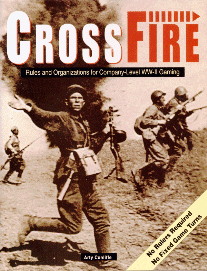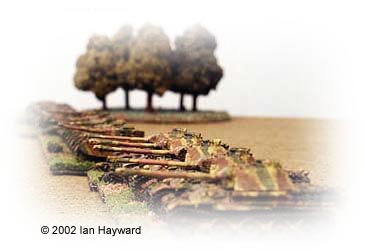 |











 Crossfire Review
Crossfire Review
 Tactical
Advice
Tactical
Advice
 Identifying Units
Identifying Units
 Tips for the
Novice
Tips for the
Novice
|
 |
 |
 |
 |
 |
 |
At Historicon in 1995 a friend challenged me
to design a historical miniatures wargame that lacked two features
present in most rulesets: rulers and fixed game turns. The result is
Crossfire - a fast-paced simulation of shifting tactical initiative,
where the action unfolds like a film highlighting the critical
events of a battle. Crossfire offers the player dozens of critical
decisions to make every game, and each one may decide the battle.
 Crossfire focuses on company-level, infantry operations by stressing
three interrelated features: movement, firepower, and terrain. It
assumes the tabletop action is occurring well within the effective
ranges of WW-II small arms. By stressing these fundamentals, player
commanders in Crossfire are encouraged to use covered terrain routes
for troop movements, and establish fire bases that both support
their own movements and interdict those of the enemy. Variable troop
quality and national command & control differences modify these
fundamentals. These conflicting tactical concerns will challenge the
best gamers in our hobby. And because these concerns were paramount
in the minds of real commanders, I believe Crossfire also succeeds
as a simulation, in spite of its abstractions. Crossfire focuses on company-level, infantry operations by stressing
three interrelated features: movement, firepower, and terrain. It
assumes the tabletop action is occurring well within the effective
ranges of WW-II small arms. By stressing these fundamentals, player
commanders in Crossfire are encouraged to use covered terrain routes
for troop movements, and establish fire bases that both support
their own movements and interdict those of the enemy. Variable troop
quality and national command & control differences modify these
fundamentals. These conflicting tactical concerns will challenge the
best gamers in our hobby. And because these concerns were paramount
in the minds of real commanders, I believe Crossfire also succeeds
as a simulation, in spite of its abstractions.
We have included a Scenario Generation system which enables gamers
to simulate typical combat problems with an infinite number of
outcomes; tournaments may be played with this method. One specific
scenario has been added showing how to design games based on
historical actions. We will be releasing a book of such scenarios in
the future.
 The average Crossfire game can be played quickly with about 40, 15mm
or 20mm figures on a side and perhaps a vehicle or two, and the game
works equally well at any figure scale. Rebasing is not required. The average Crossfire game can be played quickly with about 40, 15mm
or 20mm figures on a side and perhaps a vehicle or two, and the game
works equally well at any figure scale. Rebasing is not required.
I tried to "push the envelope" with this design, and extend the
possibilities of traditional miniatures games. Crossfire, therefore,
contains many new and unusual game mechanics. You should skim the
entire rulebook once before reading it detail.
Questions will be answered providing a SASE is enclosed. On the
Internet, there is a web page for Crossfire. SPEARHEAD is my WW-II
game for Division-level, miniatures combat for gamers who seek the
challenge of larger battles.
Arty Conliffe

You can also download the original play testers' calculations on dice
probabilities comparing the use of a 6-sided die to a 10-sided
one. For a more extensive discussion of probabilities in
Crossfire visit
Lloydian Aspects. |
 |


|
 |
 |
|

[ Home ] [ Introduction ] [ Review ] [ Hit The Dirt ] [ FAQ & Articles ] [ Reichstag ] [ More Crossfire ] [ More Research ] [ Gallery ] [ Wally Simon ] [ Wargaming.info ]
The CROSSFIRE Website is edited and maintained
by John Moher. Additional contributions were made by John Kovalic, Luca Fazio,
and William Scarvie III. CROSSFIRE is © 1996 Arty Conliffe. The contents of
these pages are © 1996-2009 John Moher, Arty Conliffe, Rob Wolsky, Bill
Rutherford, and/or the appropriate Authors and Contributors.
|
|
 |
![]() Crossfire Review
Crossfire Review![]() Tactical
Advice
Tactical
Advice![]() Identifying Units
Identifying Units![]() Tips for the
Novice
Tips for the
Novice

 Crossfire focuses on company-level, infantry operations by stressing
three interrelated features: movement, firepower, and terrain. It
assumes the tabletop action is occurring well within the effective
ranges of WW-II small arms. By stressing these fundamentals, player
commanders in Crossfire are encouraged to use covered terrain routes
for troop movements, and establish fire bases that both support
their own movements and interdict those of the enemy. Variable troop
quality and national command & control differences modify these
fundamentals. These conflicting tactical concerns will challenge the
best gamers in our hobby. And because these concerns were paramount
in the minds of real commanders, I believe Crossfire also succeeds
as a simulation, in spite of its abstractions.
Crossfire focuses on company-level, infantry operations by stressing
three interrelated features: movement, firepower, and terrain. It
assumes the tabletop action is occurring well within the effective
ranges of WW-II small arms. By stressing these fundamentals, player
commanders in Crossfire are encouraged to use covered terrain routes
for troop movements, and establish fire bases that both support
their own movements and interdict those of the enemy. Variable troop
quality and national command & control differences modify these
fundamentals. These conflicting tactical concerns will challenge the
best gamers in our hobby. And because these concerns were paramount
in the minds of real commanders, I believe Crossfire also succeeds
as a simulation, in spite of its abstractions. The average Crossfire game can be played quickly with about 40, 15mm
or 20mm figures on a side and perhaps a vehicle or two, and the game
works equally well at any figure scale. Rebasing is not required.
The average Crossfire game can be played quickly with about 40, 15mm
or 20mm figures on a side and perhaps a vehicle or two, and the game
works equally well at any figure scale. Rebasing is not required.